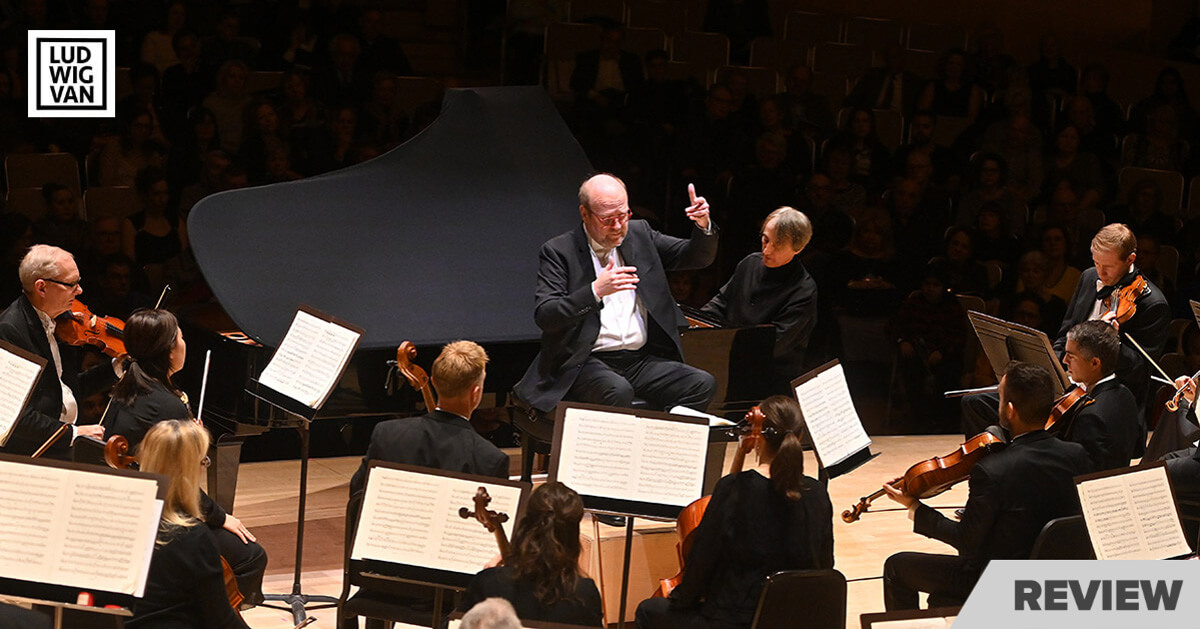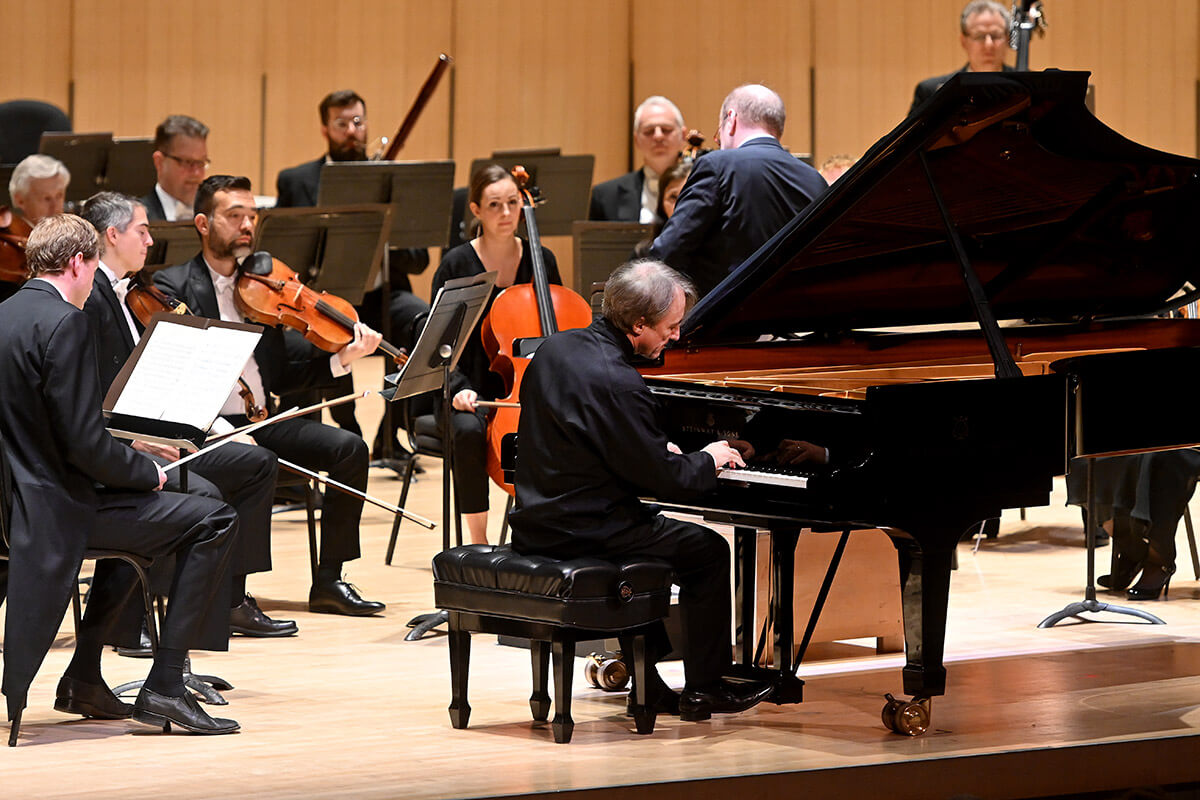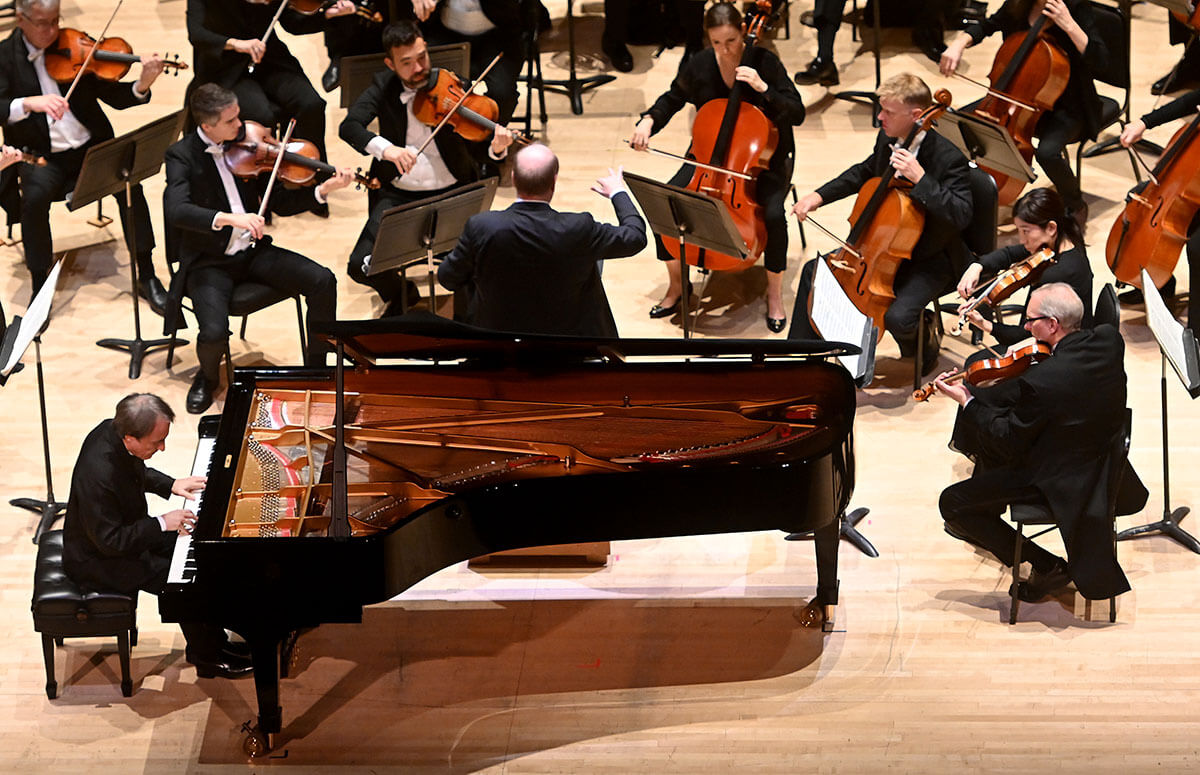All you need to perform Mozart’s Symphony No. 40 is 40 players, it turns out.

Mozart 40: Toronto Symphony Orchestra with Bernard Labadie (conductor) and Jean-Efflam Bavouzet (piano). Roy Thomson Hall, Jan 22. Repeats Jan. 23 & 26.
The Toronto Symphony Orchestra (TSO) trotted out 31 strings, 7 woodwinds and 2 brass for their “Mozart 40” concert Wednesday night at Roy Thomson Hall and had more than enough forces in their reduced chamber ensemble to create a strong, unified, and very convincing, 18th-Century orchestra.
The TSO recaptures the Classical Viennese world regularly well, particularly mid-season every January, which is informally dubbed “Mozart month.” While many of us are caught up in the Beethoven 250th anniversary celebrations, Mozart certainly has not been left out of the equation at all by the TSO executive brain-trust, which continues to offer high-quality programming virtually year-round.
For example, last week the TSO put on a fine Mozart Requiem and Symphony No. 39 and as an appropriate follow-up last night we heard Piano Concerto No. 9 (the same key as Symphony No. 39 in E-flat major) and perhaps Mozart’s most performed work in the concert hall (at least as of last century), the popular Symphony No. 40 in G minor.
Quebec early music conductor Bernard Labadie was back, and we were happy to see him yet again. This time he was here to lead a lucid if not immaculate Symphony 40, all at perfect tempi and directed with an unrestrained riot of late Mozartean colour cast in some of the composer’s most adventurous, chromatic writing.

There is quite a lot going on in these performances, but some of the more interesting and nuanced elements were sadly lost in the acoustic last night. Despite Labadie’s industrious reading and careful phrasing of each movement’s shifting orchestral textures, the tricky, meticulous balancing act of weighting each section of the TSO with each other was still sabotaged by an uncooperative acoustic. It is hard to sit still and have to hear the TSO’s finer moments and best efforts subtracted out by the hall even while they read Mozart’s remarkable inner-voiced lines consistently well, whether in the woodwinds throughout the fourth movement or the more interesting cello/bass moments in the coda of the first movement.
Yet the fugal developmental sections, so well-known in this symphony, stood out with a shine that should be the envy of any orchestra. The TSO grasps these difficult sections and gives them their fullest due, fighting off an acoustic that is determined to suppress even the most powerful efforts. Labadie and the TSO thrill, but Roy Thomson Hall disappoints, yet again.
Still, when we could hear the 40 of the TSO at their pellucid best, they were in finest contrapuntal form, a must for this and all the late Mozart symphonies. The horns captured “Section-of-the-Night Award” with many moments of refined coloration and delicately textured playing. Frequently brought out to capital effect as is required in this repertoire and later in the Beethoven symphonies, they were never reduced to mere background texture like whatbwe hewr in twentieth-century recordings and still in some performances today, which would be implausible for any eighteenth century chamber group according to a large volume of scholarship.
Also restored to proper performing practice were the seven woodwinds, here in the symphony’s revised version, rescored for two clarinets, adding much-needed ombra to the substantive string sections. And what a joy it is to hear the third movement trio with exposed horn and bassoon lines played so well.
Also, with each phrase carefully worked out and articulated with unbreaking exactitude, the first and second violins made us hang onto their every note, even in the relaxed, repeated-sectional slow movement with its occasionally angsty moments of chromatic uncertainty.
Yet, the third and fourth movements proved to be the best of the night— quick, lithe, colourful, forceful, and best of all, brooding and foreshadowing despair in their operatic topical discourse, a rarity in Mozart symphony. For Mozart, G minor became his uniquely created world for its time, much as D minor had become its own narrative universe earlier in the decade (Piano Concerto No. 20 in D minor and Don Giovanni).

Quite the opposite mood greeted Wednesday night’s audience in the programme’s first half, which featured spirited performances of both the Overture to Così fan tutte and the celebrated Piano Concerto No. 9 in E-flat Major.
Soloist Jean-Efflam Bavouzet was unsparing in his customary enthusiasm for the concerto and gave a ripping good performances of the work’s outer movements. The half-dozen finger faults were “so what” moments — Bavouzet is an artist of true interpretive gift, born to the stage and to the spontaneity each moment has to offer. He has performed and recorded Mozart and Beethoven concertos for a long time now, and his interpretive acumen was on show to its fullest extent last night.
But, he always stopped to smell the roses in the slow movement too and also took his time through the remarkable minuet that shows up unexpectedly in the middle of the third, a favourite nostalgic passage for many of us. That minuet seems so unusual, like a separate movement that was meant for something else but in the end was rejected for its original purpose and then was somehow transposed into the middle of this lighthearted rondo as though landing an elegant minuet in the midst of a quick frolic was meant to sober up the mood a little.
It’s such a gem, and all too often, I have heard performers approach it a little too matter-of-factly. Not so Bavouzet and Labadie. They take their time, the orchestra’s strings add mutes, creating a notturno effect, and the topic abruptly changes. You’re in a different concerto it seems, and with it, Bavouzet changes performance personas facilely. It was a deep sigh that outlasted a cold winter’s night well into an imagined spring yet to come.
#LUDWIGVAN
Want more updates on classical music and opera news and reviews? Follow us on Facebook, Instagram or Twitter for all the latest.
- SCRUTINY | Opera Atelier’s Film Of Handel’s ‘The Resurrection’ A Stylish And Dramatic Triumph - May 28, 2021
- HOT TAKE | James Ehnes And Stewart Goodyear Set The Virtual Standard For Beethoven 250 - December 15, 2020
- SCRUTINY | Against the Grain’s ‘Messiah/Complex’ Finds A Radical Strength - December 14, 2020



